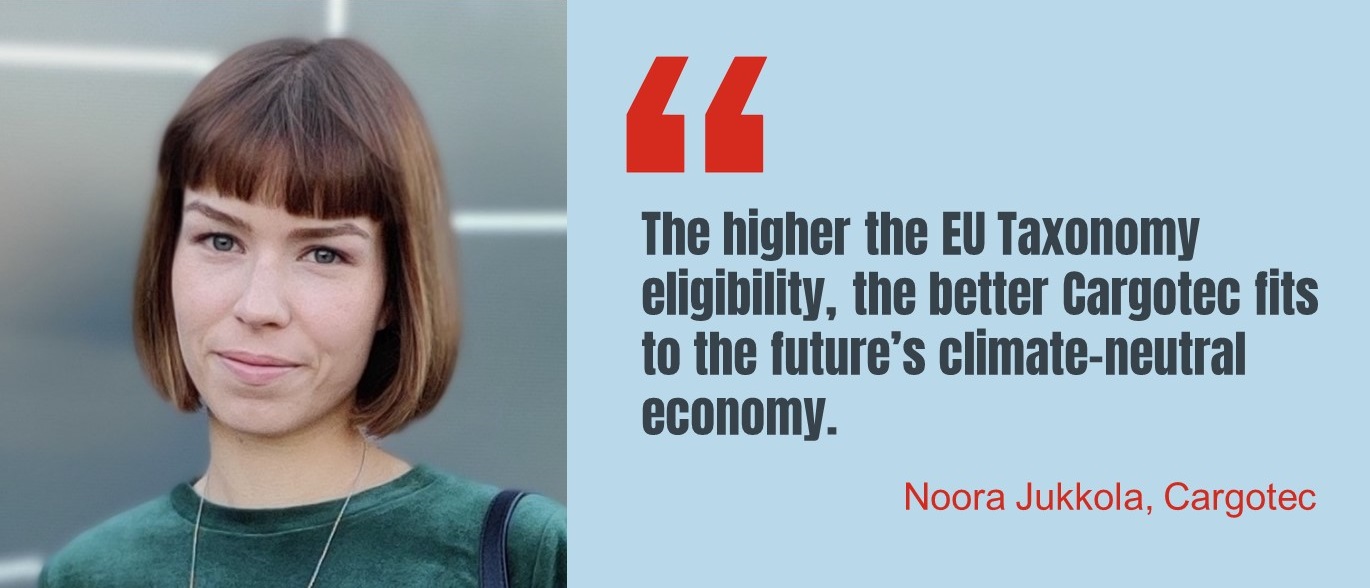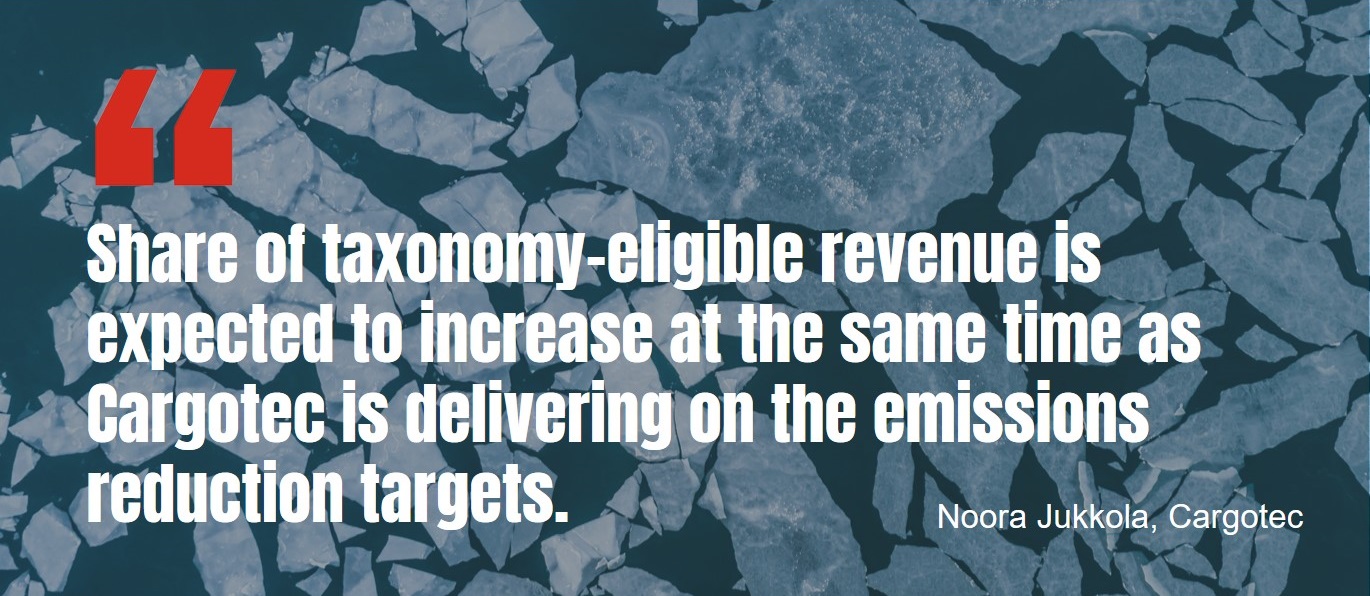EU Taxonomy - what is it that environmentally aware investors are talking about?
13/04/2021
Sustainability is the word of the day for many, if not most stock-listed companies. From an investor’s point of view, one of the related challenges has been the lack of standards and definitions concerning what actions can actually be considered sustainable. A tool to tackle this concern of greenwashing is the European Union’s Taxonomy, which classifies environmentally sustainable activities. Here’s how it works in a nutshell and how it also affects Cargotec.
AUTHOR: NOORA JUKKOLA
Increasing customer demand for sustainable solutions drives the sales of Cargotec’s eco portfolio and that is well in line with Cargotec's 1.5°C climate ambition as well as related Science Based Targets and leading to higher EU Taxonomy eligibility. To put it simply, the higher the EU Taxonomy eligibility, the better Cargotec fits to the future’s climate-neutral economy. But how does all this affect Cargotec as an investment? First, it’s important to understand what the EU Taxonomy means and the goal behind it.

EU Taxonomy in a nutshell
The EU has set an ambitious long-term goal to be climate neutral by 2050. In order to meet this goal, the private sector’s role is crucial. Therefore the EU Sustainable Finance work stream aims to channel private investment to the transition to a climate neutral economy. This will help to reach the objectives of the European Green Deal, making Europe the first climate-neutral continent.
EU Taxonomy tackles the risk of greenwashing in marketing and sales of sustainable products and solutions by providing definitions for environmental sustainability. The regulation is expected to create security, shift investments to advancing the transition to a climate-neutral economy, and therefore help companies and investors understand what activities are sustainable.
Taxonomy is a classification system to define which economic activities are environmentally sustainable. For each economic activity, technical screening criteria will determine the conditions for substantial contribution to the environmental objective.
There are six environmental objectives:
- Climate change mitigation
- Climate change adaptation
- The sustainable use and protection of water and marine resources
- The transition to a circular economy
- Pollution prevention and control
- The protection and restoration of biodiversity and ecosystems
The draft criteria have been published for the first two, climate related objectives. Cargotec’s focus is primarily on climate change mitigation, because the potential to substantially contribute to climate change adaptation is seen as limited. The criteria for the remaining environmental objectives are not yet published, but especially the transition to a circular economy objective is expected to be relevant for Cargotec.
Decarbonising cargo flow and our supply chain
The taxonomy regulation aims to decarbonise high-emitting sectors and help low-carbon sectors to grow in order to reach climate neutrality by 2050. This overall objective is fully aligned with Cargotec’s climate ambition to decarbonise our supply chain and offer low-emission solutions for our customers. Cargotec joined the Business Ambition for 1.5°C campaign of the UN Global Compact in 2020 and the related emissions reduction targets have been validated by the Science Based Targets initiative.
Cargotec’s economic activities fall into two sectors: manufacturing and information and communications technology (ICT). Within the manufacturing sector, manufacture of low carbon technologies applies to Cargotec’s equipment. The software business is aligned with the data-driven solutions for GHG emissions reduction of the ICT sector.
Cargotec manufactures eco solutions that enable other sectors to become low-carbon. For example, Kalmar’s offering for larger cranes is already available as fully electric and the mobile equipment portfolio in 2021. Electric versions are more energy efficient compared to internal combustion engines and enable zero emission operations for customers with the use of fossil free electricity.
Likewise, in 2020 MacGregor received its largest single vessel order to supply a mission-critical system on an offshore wind foundation installation vessel. This is a great example of how MacGregor is helping the offshore wind and generation of renewable energy to grow.
Share of Cargotec’s taxonomy-eligible revenue expected to increase
Carfotec’s eco portfolio was established already in 2017. The portfolio includes new equipment, service and software that provide tangible environmental benefits to customers. The offering includes for example electric and hybrid versions of equipment, ProFuture models and equipment with eco mode as well as retrofits and upgrades besides selected software products.

The criteria of the eco portfolio will be revised during 2021 to align with the EU Taxonomy. Preparing for the upcoming disclosure requirement has been initiated at Cargotec. In practical terms, proving alignment with the technical screening criteria requires Cargotec to conduct product life cycle assessment studies of the equipment. The share of taxonomy-eligible revenue is expected to increase at the same time as Cargotec is delivering on the emissions reduction targets.
The demand for low carbon solutions is expected to increase due to different drivers toward a low-carbon economy, like emerging regulation, shift in customers’ preferences, significant fund allocations to green investments and also carbon price and taxation schemes. Electrification and software are seen as the main growth drivers for Cargotec.
Cargotec’s eco portfolio also includes solutions that we consider contributing to transition to a circular economy. For example, upgrades and retrofits prolong the use time of the equipment which is one of the qualification elements as stated in the Taxonomy regulation (2020/852, article 13). However, the circular economy objective will be included in the Taxonomy regulation at a later stage.
Economic and environmental goals aligned
Cargotec is preparing to disclose the proportion of revenue as well as capital expenditure and operating expenses that qualifies as taxonomy eligible as part of its disclosure of non-financial issues in the annual report 2022. As the classification is based on economic activities, it means that the taxonomy is not intended to classify companies as either sustainable or not. Cargotec’s taxonomy figure will be determined based on products and services that qualify as environmentally sustainable.
We believe that intelligent cargo handling is the solution to half the emissions across our value chain by 2030 from a 2019 base year. At the same time, intelligent cargo handling solutions are expected to meet the performance thresholds of EU taxonomy.
Watch Cargotec's Sustainability IR event presentation on Youtube
Read Cargotec's Sustainability presentation for investors
